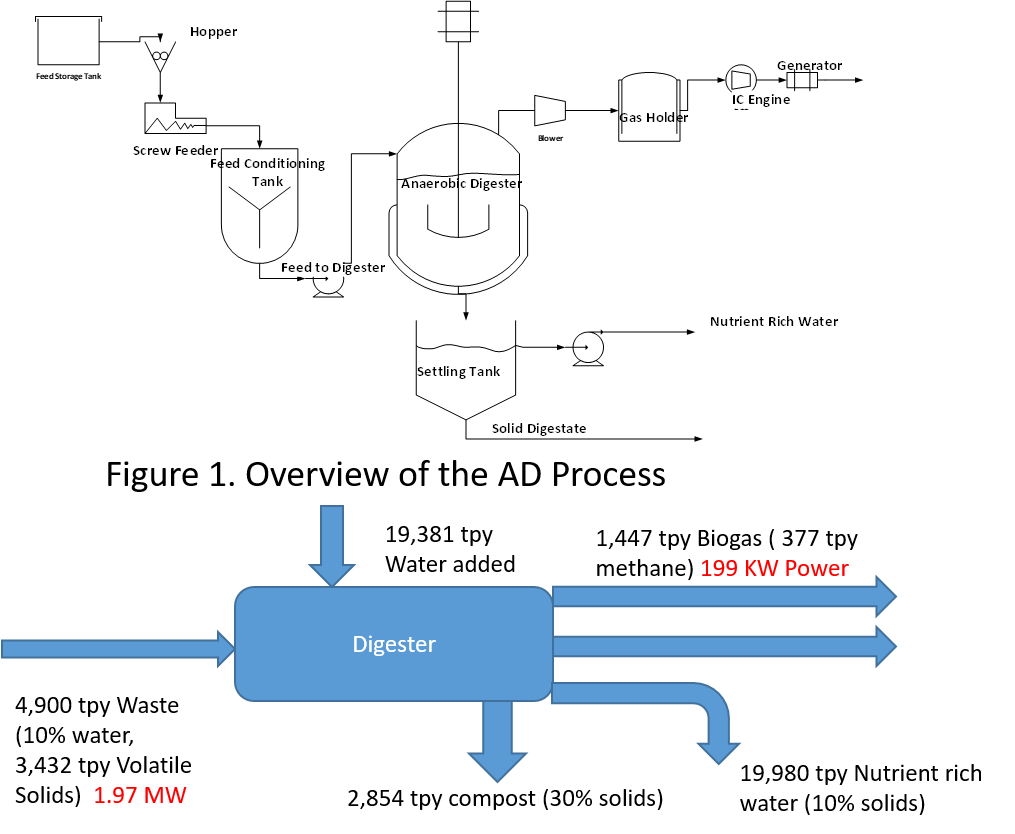(728c) A Techno-Economic Analysis of Greenhouse Waste and Water Recycling Using Anaerobic Digestion: A Case Study in Food-Energy-Water Nexus
AIChE Annual Meeting
2020
2020 Virtual AIChE Annual Meeting
Forest and Plant Bioproducts Division
Biotechnical Solutions for Food-Energy-Water (FEW) Nexus
Friday, November 20, 2020 - 8:30am to 8:45am
Anaerobic digestion (AD) of the waste represents a potential route to create an integrated and sustainable agricultural model (Kalra and Panwar 1986, Corneli, Dragoni et al. 2016, Sukhesh and Rao 2018). As shown in attached figure, AD produces mainly 4 product streams all of which have value associated with it. The biogas produced can be used to generate heat and power both of which are needed commodities for greenhouse operation. The waste water produced is rich in nutrients and therefore can supply much needed irrigation water thus reducing the stress on local aquifers and desalination plants, which is a critical issue in the South-East of Spain. The solid digestate produced can be converted to compost manure after treatment and thus forms a source of organic fertilizer for the next round of crops. The main issue facing the application of this technology is one of economics. Implementation of such a waste recycling system can provide a sustainable solution from the point of view of Food-Water-Energy Nexus as applied to greenhouse agriculture (Haltas, Suckling et al. 2017, Hoolohan, Soutar et al. 2019, Falconer, Haltas et al. 2020).
For the case study, we selected a 100 hectare greenhouse cooperative and carried out an assessment of the economics of constructing and operating an AD system from the crop residues produced. Based on prior studies, the total crop residues was estimated at 4900 tonnes/year (tpy) containing about 3400 tpy of Volatile Solids (VS) and about 500 tpy of water. Additional water needed for dilution in the AD was estimated at 20,000 tpy. The biogas production from the digester was estimated at 1400 tpy containing 660 KW of energy which is roughly 1/3 of the energy content in the waste biomass. The biogas can be used to produce nearly 200 KW of electricity and 460 KW of heat energy both of which are needed in the greenhouse operation and therefore directly recyclable. The wet digestate is sent to a filtration system where much of the water enriched with nutrients is recovered. Therefore ,after some pretreatment, this water can be recycled back for greenhouse irrigation. Likewise the solid digestate is rich in minerals and after treatment, becomes valuable as a compost fertilizer which is also a needed commodity for the greenhouse cultivation.
In this paper, we will present the results of a preliminary economic analysis of the process. We will take a look at the economic feasibility of the process as well as the sensitivity to variables such as waste disposal tipping fee, capital expenditures required and the cost of energy recovered from the AD system.
References
Cherubin, M. R., D. M. D. Oliveira, B. J. Feigl, L. G. Pimentel, I. P. Lisboa, M. R. Gmach, L. L. Varanda, M. C. Morais, L. S. Satiro, G. V. Popin, S. R. de Paiva, A. K. B. dos Santos, A. L. S. de Vasconcelos, P. L. A. de Melo, C. E. P. Cerri and C. C. Cerri (2018). "Crop residue harvest for bioenergy production and its implications on soil functioning and plant growth: A review." Scientia Agricola 75(3): 255-272.
Corneli, E., F. Dragoni, A. Adessi, R. De Philippis, E. Bonari and G. Ragaglini (2016). "Energy conversion of biomass crops and agroindustrial residues by combined biohydrogen/biomethane system and anaerobic digestion." Bioresource Technology 211: 509-518.
Egea, F. J., R. G. Torrente and A. Aguilar (2018). "An efficient agro-industrial complex in Almeria (Spain): Towards an integrated and sustainable bioeconomy model." New Biotechnology 40: 103-112.
Falconer, R. E., I. Haltas, L. Varga, P. J. Forbes, M. Abdel-Aal and N. Panayotov (2020). "Anaerobic Digestion of food waste: Eliciting sustainable water-energy-food nexus practices with Agent Based Modelling and visual analytics." Journal of Cleaner Production 255.
Haltas, I., J. Suckling, I. Soutar, A. Druckmann and L. Varga (2017). "Anaerobic digestion: a prime solution for water, energy and food nexus challenges." Proceedings of 1st International Conference on Sustainable Energy and Resource Use in Food Chains (Icfes 2017), Including Symposium on Heat Recovery and Efficient Conversion and Utilisation of Waste Heat 123: 22-29.
Hoolohan, C., I. Soutar, J. Suckling, A. Druckman, A. Larkin and C. McLachlan (2019). "Stepping-up innovations in the water-energy-food nexus: A case study of anaerobic digestion in the UK." Geographical Journal 185(4): 391-405.
Kalra, M. S. and J. S. Panwar (1986). "Anaerobic-Digestion of Rice Crop Residues." Agricultural Wastes 17(4): 263-269.
Sayadi-Gmada, S., C. R. Rodriguez-Pleguezuelo, F. Rojas-Serrano, C. Parra-Lopez, S. Parra-Gomez, M. D. Garcia-Garcia, R. Garcia-Collado, M. B. Lorbach-Kelle and T. Manrique-Gordillo (2019). "Inorganic Waste Management in Greenhouse Agriculture in Almeria (SE Spain): Towards a Circular System in Intensive Horticultural Production." Sustainability 11(14).
Sukhesh, M. J. and P. V. Rao (2018). "Anaerobic digestion of crop residues: Technological developments and environmental impact in the Indian context." Biocatalysis and Agricultural Biotechnology 16: 513-528.
Turhollow, A., R. Perlack, L. Eaton, M. Langholtz, C. Brandt, M. Downing, L. Wright, K. Skog, C. Hellwinckel, B. Stokes and P. Lebow (2014). "The updated billion-ton resource assessment." Biomass & Bioenergy 70: 149-164.
Checkout
This paper has an Extended Abstract file available; you must purchase the conference proceedings to access it.
Do you already own this?
Log In for instructions on accessing this content.
Pricing
Individuals
| AIChE Pro Members | $150.00 |
| AIChE Emeritus Members | $105.00 |
| AIChE Graduate Student Members | Free |
| AIChE Undergraduate Student Members | Free |
| AIChE Explorer Members | $225.00 |
| Non-Members | $225.00 |
